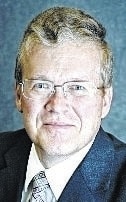
Highland District Hospital is exploring the possibility of establishing a new one or two-day a week pain management program in response to requests from local doctors who say their patients need better local access to manage chronic pain.
Several local residents and some hospital employees have contacted The Times-Gazette in recent days expressing concerns about the idea.
Randy Lennartz, CEO of HDH, confirmed Monday that HDH is exploring the option at the request of local doctors and practitioners.
Lennartz said doctors have told hospital officials there is a “real need” for more pain management locally, because many of their patients cannot travel to Cincinnati, Dayton, Columbus or even Washington Court House for pain management treatments.
“Some just don’t have the gas money,” said Lennartz.
So, HDH has been “looking at presentations” on how such a clinic could be responsibly managed, and Lennartz mentioned Pain Management Group (PMG) as one possible provider. PMG operates more than 40 treatment centers, mostly in Ohio, including at Fayette Memorial Hospital in Washington Court House.
PMG “establishes joint-venture partnerships with community hospitals to develop and operate pain management facilities that provide patients with the highest level of health care,” according to its program description. In addition to Fayette Memorial, hospitals with which it partners include Mount Carmel in Columbus, Berger Hospital in Circleville and Hocking Valley Community Hospital in Logan.
Lennartz said PMG is a “very reputable program” using only board certified doctors. He said that if HDH approves such a program, “it won’t be a pill mill.”
So-called “pill mills” were the focus of legislative action in Ohio a few years ago targeting clinics that were found to be little more than unregulated dispensaries of opiates. By 2014, Ohio Attorney General Mike DeWine estimated that since 2011, 53 doctors and 13 pharmacists had lost their licenses for improperly prescribing or dispensing prescription drugs after the state cracked down.
Lennartz said he is sensitive to such concerns in an environment where drug overdoses and deaths have reached epidemic proportion. He said that’s why the hospital has been moving slowly, and only after doctors asked HDH to explore the possibility.
Barbara Yochum, president of the HDH board of governors, said Monday she is looking forward to an upcoming Finance Committee meeting where a presentation on the clinic will be made to board members.
“We’re going to be given information about it,” she said. She said she is expecting a powerpoint presentation followed by a question and answer session.
“I’m still at a learning point,” she said, adding that the hospital is still in the “fact-finding” stage, and board members want to analyze the cost benefit in regard to the health care of local patients.
“I want to know how we can take care of people who need this,” she said. “No decision has been made,” she added. She said the hospital is in the “exploration stage,” and she has been doing her own research on the subject.
Lennartz said that if HDH agrees to such a clinic, it likely would not be operational until February or March of next year. He said it would be similar to programs operating currently in Washington Court House, Logan and Circleville, where clinics operate one or two days a week. He said pain management can range from physical therapy to posture correction to prescriptions.
Lennartz said Dr. Amol Soin, a pain management specialist at HDH who focuses on non-narcotic treatments and minimally invasive procedures, will continue his program at HDH, but has also expressed the need for additional help in working with patients to manage pain.
Concerns expressed by those who contacted The Times-Gazette were in regard to the drug epidemic sweeping southern Ohio and the growing rate of overdose deaths.
The Associated Press reported over the weekend that Ohio’s accidental drug deaths continue to skyrocket. Ohio overdose deaths have gone up annually over the past decade, from 1,515 in 2006 to 2,744 in 2015, according to an analysis. That 81-percent increase is the 7th highest among U.S. states over the period, the analysis found. The AP explored the influence of pharmaceutical lobbyists in regard to laws in Ohio and across the country.
“I don’t know if it’s going to happen,” said Lennartz in regard to the possibility of a new pain management program at the hospital. He said he is “a little disappointed” if anyone thinks HDH would operate a program that was not carefully monitored and responsibly administered. He said despite the stereotypical belief that a clinic would be abused by “druggies,” he believes Medicare patients will be the primary recipients who are served.
“This is not a drug program,” he said. “It’s a pain management program. We want to look at everything.”
Reach Gary Abernathy at 937-393-3456 or on Twitter @abernathygary.


